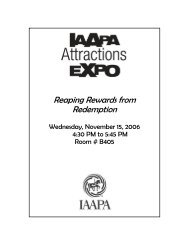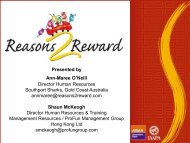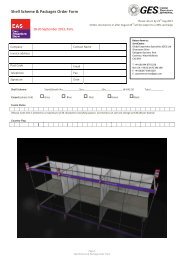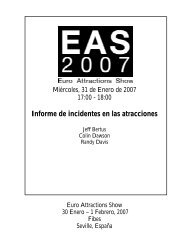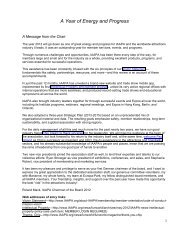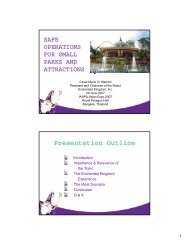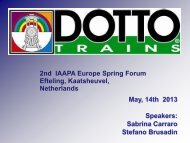Family Entertainment Centers - IAAPA
Family Entertainment Centers - IAAPA
Family Entertainment Centers - IAAPA
Create successful ePaper yourself
Turn your PDF publications into a flip-book with our unique Google optimized e-Paper software.
HOW • TO<br />
by Christina<br />
MacDonald<br />
Partner with<br />
Local Businesses<br />
Self-sufficiency may be a prized trait in our culture, but<br />
being a lone ranger can be a big mistake for a midsize company,<br />
especially in an increasingly global economy.<br />
Partnering with local businesses might be the key to<br />
longevity given the strength of the alliance. Julie Deon,<br />
vice president of sales and marketing for Adventure<br />
Landing FECs in Florida, lists her prerequisites for partnering<br />
with local businesses to attain mutually beneficial goals.<br />
STEP 1 Cater to Your Niche Demographic<br />
Deon says a surefire way to boost park awareness and the bottom<br />
line is to pair with local companies and tailor events to<br />
community subsets. To tap into her local animal-enthusiast<br />
demographic, Deon planned a daylong event for dog lovers<br />
by asking six animal shelters and 20 pet-related vendors to<br />
attend. With each vendor paying Adventure Landing a certain<br />
amount to exhibit, both the park and the companies<br />
benefited from the large turnout.<br />
STEP 2 Target Businesses That Share Your Mission<br />
“We partner with local businesses that are trying to tap into<br />
the family audience that likes to have fun,” says Deon. “This<br />
is a proven plan for success.” Deon approached the local PBS<br />
affiliate and asked it to sponsor a “Learn to Read” day for<br />
children and parents. The park didn’t have a big budget but<br />
offered PBS a chance to have one of its kid-friendly characters,<br />
Arthur, at the park to promote the show. The park also<br />
publicized the affiliate by putting the logo on all advertising<br />
collateral used to promote the event. In exchange, the affiliate<br />
promoted the facility through free commercials.<br />
STEP 3 Put Yourself in Their Place<br />
Deon relays the importance of third-party tie-ins: “It’s always<br />
good to have a promotion established, as this increases awareness<br />
and provides credibility to the campaign. You have to<br />
approach the partnership with the underlying maxim of ‘How<br />
will they benefit from this partnership? Are they looking for<br />
branding, on-air exposure, radio tags, or park signage?’”<br />
However, Deon conveys the importance of having a qualitative<br />
sales booklet where values are assigned to all promotional<br />
exposure opportunities you can provide. “Always have a starting<br />
point for park signage,” she says. “It’s all negotiable and can<br />
be customized to meet both of your goals, but this keeps your<br />
best interest intact.”<br />
18 FUNWORLD<br />
STEP 4 Consider Working with Charities<br />
Deon suggests pairing with charities that are proactive in the<br />
community. “Look for a sophisticated charity,” she says. “One<br />
that can do e-mail blasts and spread the word on your company.”<br />
Deon relays the win-win situation that came as a result of<br />
partnering with the local Boys and Girls Club. “Oftentimes,<br />
large charities are underwritten by large companies,” Deon<br />
remarks. “Our Boys and Girls Club chapter is underwritten by<br />
CitiBank. CitiBank provided us with 20 of their employees who<br />
staffed the event and allowed us to save exponentially as a<br />
result.”<br />
STEP 5 Host Fund-raisers That Give Back<br />
According to Deon, nothing brings in the bucks like<br />
approaching a local company to see if it is interested in organizing<br />
a team-building event at your park during the slow season,<br />
where proceeds benefit a charity. “We are always talking<br />
to companies in our community between September and<br />
October,” says Deon. “We basically sell the tickets at a discounted<br />
rate to a company that wants to promote the event<br />
in-house and then the company sells those tickets at a higher<br />
price to their employees with proceeds going to a charity.<br />
Everyone benefits as a result.”<br />
STEP 6 Be Creative<br />
“You need to focus on different ways to attract whichever audience<br />
you are trying to draw in,” says Deon. “And sometimes<br />
this requires thinking outside the box and researching what<br />
these demographics spend their money on.” To bring in mothers<br />
and children during the park’s off-season, Deon partnered<br />
with a local make-your-own pottery company. Both parties<br />
promoted the program on their web sites and in the end benefited<br />
from the enhanced sales.<br />
STEP 7 Contact the Airport, Not the Airline<br />
When the president and CEO of Delta Airlines failed to<br />
return her call regarding a one-off promotion, Deon struck<br />
gold by contacting the Daytona International Airport’s marketing<br />
department. By making a contact at the airport, Deon<br />
was able to promote the park in a “register to win a free trip<br />
to Daytona” promotion, including free airfare, hotel accommodations,<br />
and tickets to the park. The park’s logo made it<br />
onto the company’s advertising collateral, which was aggressively<br />
promoted in multiple U.S. markets.<br />
F E C E d i t i o n n F U NW O R L D C O L L E C T I O N S 5




